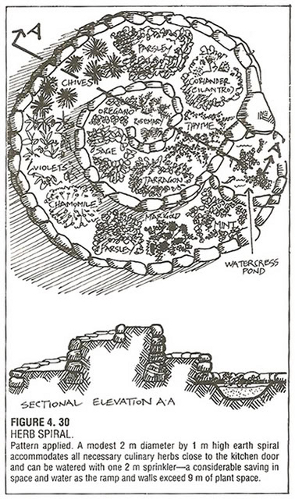
Hooker's videos on design, patterns, and gardens
 Despite getting carried away and finishing
up Mollison's book before moving on with Will
Hooker's video course, I didn't completely give up on the latter. Over
the last few weeks, I've worked my way through lectures 6, 7, and
8, along with the corresponding reading material about
permaculture as a design process, about patterns, and about
starting a vegetable garden.
Despite getting carried away and finishing
up Mollison's book before moving on with Will
Hooker's video course, I didn't completely give up on the latter. Over
the last few weeks, I've worked my way through lectures 6, 7, and
8, along with the corresponding reading material about
permaculture as a design process, about patterns, and about
starting a vegetable garden.
All three lectures
were pretty basic, and lecture 7, especially didn't contain much
of value. (I felt Will Hooker got a bit caught up in what I
consider New Age math.) On the other hand, gems jumped out
at me from the other two videos.
In addition to the
sun angle information that I'm going to devote a later post to, my
favorite part of lecture 6 was the notion of beginning the design
process with a sector analysis. The image at the top of this
post charts where forces of nature (and other elements beyond our
control) enter the farm. Although we already know our farm
well enough that we didn't receive any new information from the
sector analysis, those of you new an area might use the
information in a sector analysis to conclude you shouldn't plant
your fruit trees where they'll block the winter sun, that you should plant a dense barrier
where the wind comes gusting in off the prairie, and that you
might consider either making an edible garden where the neighbor's
children encroach, or keeping them out with thorny bushes
(depending on how you feel about the kids in question).
 Shifting gears, Lecture 8
contained a good introduction to permaculture gardening techniques
--- I recommend that video for beginners. I enjoyed Hooker's
reiteration of the admonition to start gardening wherever you are,
even if you're renting; your first garden will be far from
perfect, so you might as well begin the trial and error process
now rather than putting it off until you have the perfect
plot. He also scavenges
biomass just
like I do, and has an excellent piece of advice there --- steer
clear of bags of clippings and leaves from beautiful lawns, since
those are more likely to be dosed in herbicides.
Shifting gears, Lecture 8
contained a good introduction to permaculture gardening techniques
--- I recommend that video for beginners. I enjoyed Hooker's
reiteration of the admonition to start gardening wherever you are,
even if you're renting; your first garden will be far from
perfect, so you might as well begin the trial and error process
now rather than putting it off until you have the perfect
plot. He also scavenges
biomass just
like I do, and has an excellent piece of advice there --- steer
clear of bags of clippings and leaves from beautiful lawns, since
those are more likely to be dosed in herbicides.
As usual, I had mixed
feelings about the reading in Gaia's Garden. Even though I tried out
keyhole beds when I was new to permaculture, I believe both keyhole
beds and herb spirals are trendy techniques that create much
more work than old-school straight lines and rectangles. On
the other hand, I do like the concept of designing from patterns
to details, looking at the flows and patterns already present in
your landscape, and optimizing them. For example, Hemenway
explains that a tree's branch design is a useful pattern to mimic
in drip irrigation systems, and that people tend to flow like
water.
I've got a bit more
to say about this trio of lectures in later posts, but for now,
here's the reading material for the next set of lectures:
- Chapters 2 and 4 in Building
Soils for Better Crops. (Free download.)
- NRCS
Soil Biology Primer. (Read for free online.)
- Cornell
Soil Health Assessment Manual. (Free download.)
- Gaia's
Garden chapter 4 (soil)
- Introduction to Permaculture chapter 5 (home garden)
If you've been
watching along with me, I'd be curious to hear if different parts
of these lectures caught your interest than caught mine.
Want more in-depth information? Browse through our books.
Or explore more posts by date or by subject.
About us: Anna Hess and Mark Hamilton spent over a decade living self-sufficiently in the mountains of Virginia before moving north to start over from scratch in the foothills of Ohio. They've experimented with permaculture, no-till gardening, trailersteading, home-based microbusinesses and much more, writing about their adventures in both blogs and books.
Want to be notified when new comments are posted on this page? Click on the RSS button after you add a comment to subscribe to the comment feed, or simply check the box beside "email replies to me" while writing your comment.
- Remove comment
